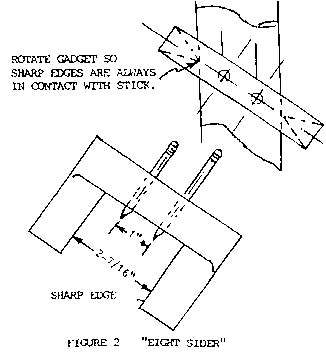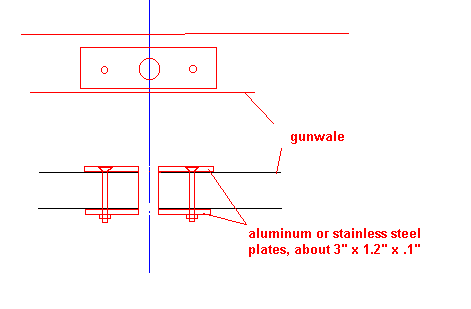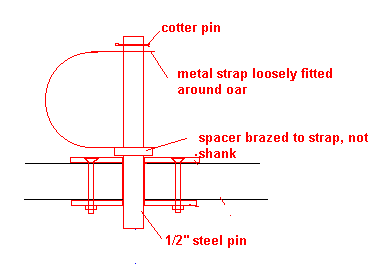Jim Michalak's Boat Designs
Making Oars
I decided to rerun these rowing articles that first appeared here in the
winter of 98-99. I've left out some of the details that appeared in those
issues and added other details.
MAKING A SET OF OARS
I'm going to show drawings for 7' oars which are about the most useful length
for me.
WHAT KIND OF OARS
The oars I make are really derived from the patterns of the late Pete
Culler. They are characterized by having heavy square looms inboard of the
locks and long narrow blades in the water. An example is shown in Figure
1.
The square looms are easy to build, help balance the oar, help locate
the oar in the locks, and keep the oar from rolling around on the wales.
The long narrow blades go against modern thinking of spoons, but
for long distance rowing, long and narrow is the way to go. The average mortal
can only pull so much of a load, in spite of what an Olympian might do. The
Culler blades can match the mortal's pull. They might slip a bit when starting
a heavy boat from a standstill, but once up to speed, the have full grip
on the water. They balance better. They are less fatiguing. They have less
windage. By the way, the oars of traditional Irish caurrahs have no blades
on their oars. Neither do the paddles of some traditional kayaks.
WHAT YOU NEED
Oars are made from four materials - wood, glue, leathers and varnish.
For wood, I use 1x6 pine boards. The pattern shown in Figure 1 will
just barely make an oar from a 1x6. I try to buy a single board long enough
to get out both oars. For example, for a pair of 7 foot oars, I buy a board
14 feet long if I can. That way the oars will be a close match on weight,
stiffness, and color I like to use soft wood like pine, It is easy to work
and makes a light oar. It need not be clear wood although clear is easier
to work Small solid knots are fine and look good too. I've never worried
too much about grain because the sticks get laminated and tend to stay straight.
But the straighter the grain the better.
For glue I prefer plastic resin "Weldwood" glue and doubt if there
is anything better for making oars. Pour some in a cup and squirt in cold
water until it has the consistency of normal woodworking glue like "Elmer's.
I've found it to quite true that this glue will not set properly until it
is a t 70 degrees F for twelve hours like it says on the can. But don't hesitate
to use epoxy if you already have it on hand.
For leathers I don't use leather. I bind the 8 inches just below
the square section of the loom with synthetic mason's twine, about 3/32"
diameter. It lasts for years.
For varnish I use ordinary oil based spar varnish.
Now let's talk tools. The tool I use the most in making oars is a
bandsaw and I hate to say that because it's not a cheap or small thing that
everyone will have. The problem is that you've got to saw a 2-1/4" thick
blank. Hand saws will work and the effort should get you in shape for rowing.
After all, oars were invented long before the bandsaw. But I see Dave Carnell
has built oars using his table saw and others have built oars with a sabersaw.
HOW TO BUILD
First cut the 1x6 boards to the proper length. lay out the centerline
with a straight edge. Then draw the pattern for the center piece, the one
with the blade, around the centerline. Cut out the center lamination following
the line closely with your saw, because the outer laminations of the blank
are made from the off fall and there isn't much extra.
You can draw patterns of the outer pieces and cut them out. But it's
easier to glue the pieces directly to the center piece and trim them after
the glue cures. Trial fit the outer pieces. You may have to trim them for
the proper shape where they blend into the blade area of the centerpiece.
When you are satisfied, butter them up well with glue, and clamp them in
place. You may need to tap in a a light temporary nail to keep the pieces
from sliding around on each other because almost all glues are quite slippery
until they start to set. Try to get glue squeezed out all around. And be
sure the blank is resting straight while curing. Walk away from the blanks
until the glue has cured hard.
After cure, trim the outer pieces to match the centerpiece. Use a
plane and sander to work these pieces to their final lines, being careful
that these faces remain square to the other two unworked faces.
Now cut the two unworked faces of the handle and loom of the oars
to their final dimensions. Draw centerlines down the two worked faces and
lay out the shape of the handle and loom. Cut to the lines and sand smooth.
At this point the cross section of the oar from handle to loom is square.
The oar drawing shows how much of the loom is left square. The rest
is to rounded. You start by drawing lines on handle and loom that allow you
to make the cross sections octagonal. You can draw them using the gadget
shown in Figure 2. Then cut down to the lines with a half round rasp where
the lines blend to the square section of the loom. Then use a drawknife or
plane to remove the rest of the material down to the lines along the shaft.
Now she's eight sided. To round it you're supposed to sixteen side it and
then round it out. To tell you the truth, I leave mine eight sided, including
the handle and the area which fits in the rowlock.
Lastly you need to trim mass out of the blade. I plane the blade down
so its edges are 1/4" thick. Then I use the front roller of my belt sander
to hollow the blade slightly on either side of the center, leaving a ridge
in the center.
I think the only critical part of these oars strength wise is the 1-1/4"
section where the blade meets the loom.
Give the oars a good overall sanding, but leave the handles rough.
Wrap the rowlock area, from the square section down 8 inches toward
the blade, with mason's twine. Wrap it tightly and use knots to secure it.
Give the oars three coats of spar varnish. That includes putting
varnish on the twine binding. It will go a long way towards holding the binding
in place. Don't varnish the handles.
An easy and effective "button" can be made be added to the bound
area, to provide a stop which will locate the oar lengthwise in the lock,
by wrapping it tightly with three wraps of 1/4" shock cord, and tying the
cord with a square knot. If the tension in the cord is right, it will stay
firmly in place while rowing and yet allow repositioning up and down the
bound area to change rowing leverage when required.
OARLOCK SOCKETS
If your hull's side have limited flare, say less than 15 degrees,
you can make some cheap oarlock sockets that are as good as store bought.
I got the idea for these, plus the oarlocks that follow, from Phil Bolger
who used them on his Spur 2 rowing boat that appears in his book BOATS WITH
AN OPEN MIND.
Here is how it's done.
What we have here is simply two metal plates bolted to the wale with the
proper sized hole (usually 1/2") drilled in each. Phil had his made of stainless
steel. I made mine out of aluminum and have had no problems. I used an aluminum
yardstick of the type carried by lumberyards for use with drywall as the
basic material. I think the metal is about 1/10" thick and about 1-1/8" wide.
I cut the aluminum to 3" lengths, stacked them up and drilled the oarlock
hole and the bolt holes all at the same time. Filed off any sharp edges.
Clamped the plates in the proper position and drilled the wooden wale. Bolted
the plates in position and that's it. These work well because the oarlock
bears on the metal parts which are about 1" apart, a bit more than the usual
shallow factory sockets. So far I haven't worn them out. By the way, it helps
to grease any oarlock from time to time, ordinary Vasoline works well.
BOLGER OARLOCKS
I haven't tried these but Phil swears by them. It is really a thole
pin with a bracket to retain the oar. Phil has always said that thole pins
are better than the usual factory oarlock where the oar centers directly
over the rotating pin. With a traditional fixed thole pin the oar rotates
around the fixed pin as it bears against it and Phil says that is a better
motion than with the factory oarlocks. The pin shown here could also be
fixed, the bracket rotating around the pin with the oar! I should try these.




